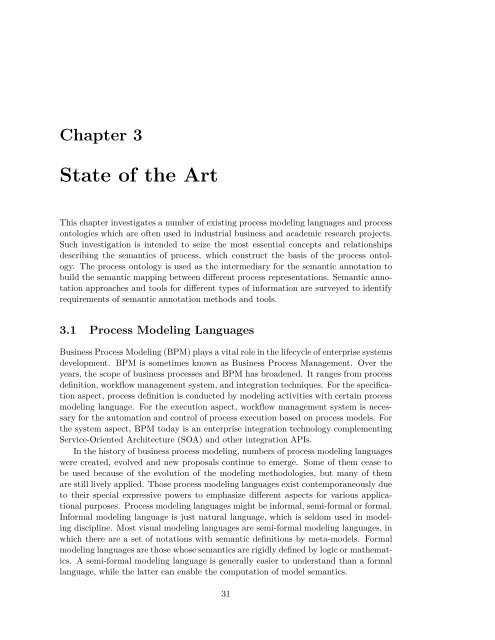Semantic Annotation for Process Models: - Department of Computer ...
Semantic Annotation for Process Models: - Department of Computer ...
Semantic Annotation for Process Models: - Department of Computer ...
You also want an ePaper? Increase the reach of your titles
YUMPU automatically turns print PDFs into web optimized ePapers that Google loves.
Chapter 3<br />
State <strong>of</strong> the Art<br />
This chapter investigates a number <strong>of</strong> existing process modeling languages and process<br />
ontologies which are <strong>of</strong>ten used in industrial business and academic research projects.<br />
Such investigation is intended to seize the most essential concepts and relationships<br />
describing the semantics <strong>of</strong> process, which construct the basis <strong>of</strong> the process ontology.<br />
The process ontology is used as the intermediary <strong>for</strong> the semantic annotation to<br />
build the semantic mapping between different process representations. <strong>Semantic</strong> annotation<br />
approaches and tools <strong>for</strong> different types <strong>of</strong> in<strong>for</strong>mation are surveyed to identify<br />
requirements <strong>of</strong> semantic annotation methods and tools.<br />
3.1 <strong>Process</strong> Modeling Languages<br />
Business <strong>Process</strong> Modeling (BPM) plays a vital role in the lifecycle <strong>of</strong> enterprise systems<br />
development. BPM is sometimes known as Business <strong>Process</strong> Management. Over the<br />
years, the scope <strong>of</strong> business processes and BPM has broadened. It ranges from process<br />
definition, workflow management system, and integration techniques. For the specification<br />
aspect, process definition is conducted by modeling activities with certain process<br />
modeling language. For the execution aspect, workflow management system is necessary<br />
<strong>for</strong> the automation and control <strong>of</strong> process execution based on process models. For<br />
the system aspect, BPM today is an enterprise integration technology complementing<br />
Service-Oriented Architecture (SOA) and other integration APIs.<br />
In the history <strong>of</strong> business process modeling, numbers <strong>of</strong> process modeling languages<br />
were created, evolved and new proposals continue to emerge. Some <strong>of</strong> them cease to<br />
be used because <strong>of</strong> the evolution <strong>of</strong> the modeling methodologies, but many <strong>of</strong> them<br />
are still lively applied. Those process modeling languages exist contemporaneously due<br />
to their special expressive powers to emphasize different aspects <strong>for</strong> various applicational<br />
purposes. <strong>Process</strong> modeling languages might be in<strong>for</strong>mal, semi-<strong>for</strong>mal or <strong>for</strong>mal.<br />
In<strong>for</strong>mal modeling language is just natural language, which is seldom used in modeling<br />
discipline. Most visual modeling languages are semi-<strong>for</strong>mal modeling languages, in<br />
which there are a set <strong>of</strong> notations with semantic definitions by meta-models. Formal<br />
modeling languages are those whose semantics are rigidly defined by logic or mathematics.<br />
A semi-<strong>for</strong>mal modeling language is generally easier to understand than a <strong>for</strong>mal<br />
language, while the latter can enable the computation <strong>of</strong> model semantics.<br />
31
















